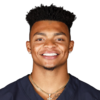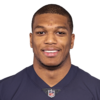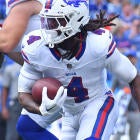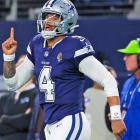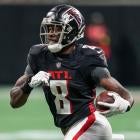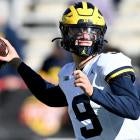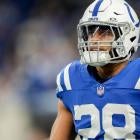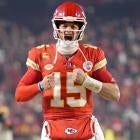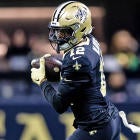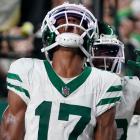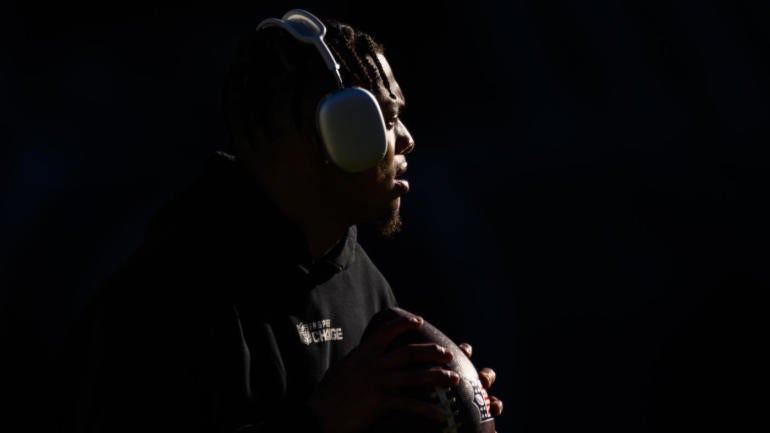
LAKE FOREST, Ill. -- If there's an offseason playbook to greatly improve a team's offense, perhaps utilized by the Bills and Eagles recently, and even by the Patriots many years ago, then the Chicago Bears have copied it.
Promising young quarterback? Check.
Acquisition of a high-quality, No. 1-caliber wide receiver? Done.
Fortified O-line? You betcha.
The Bills put Josh Allen behind a quality offensive line and paired him with Stefon Diggs. Jalen Hurts got a commitment from the Eagles, who landed A.J. Brown and already had a talented offensive line. Heck, even once upon a time Tom Brady went from a good thrower to a flamethrower because the Patriots reeled in Randy Moss.
The Bears pulled off their version of this game plan when they traded the No. 1 overall pick in April's draft away to the Panthers for wide receiver D.J. Moore and a package of picks. It is their hope that this chemistry experiment yields similar results for third-year quarterback Justin Fields.
Even if it comes at the expense of other receivers.
Or with the caveat that Fields is an improved passer, but still not quite a consistently accurate one.
Or if it means Fields will run for fewer yards than he did in 2022.
After studying this offense and talking to coaches and players during Chicago's June minicamp practices, there's reasonable evidence to suggest moderate success for Fields' Fantasy value -- and the Fantasy values of all Bears players.
A full-fledged mega-breakout where he flirts with being the highest-scoring Fantasy quarterback? That's tougher to believe.
Staying in place
The talk of Fields not relying on his feet has been a storyline in Chicago going back to late last season. Moments after he notched his 1,000th rushing yard in Week 15 against the Eagles, Fields was reluctant to commit to making rushing a permanent part of his game.
"I don't plan on rushing for 1,000 yards every year," Fields matter-of-factly said.
How important were Fields' rushing numbers? Last year's 1,148 yards and eight scores on the ground amounted to 52.8% of his total Fantasy points for the season. It was vital to his success because his 149.5 passing yards per game were awfully pedestrian.
Bears offensive coordinator and play caller Luke Getsy has dismissed the idea of moving Fields closer to a pocket passer, but when it comes to the quarterback's tendency to run when things break down, he believes there's a better way.
"I don't think it's necessarily that we just plainly want him to run less," Getsy told CBS Sports inside Halas Hall after the Bears' first minicamp practice. "I think we want him to get hit less, I think we want him to process better, for his protection to be better. We want all of that to be better. When all that is better, then it should lead to less (running). It's not necessarily a desire of it."
The logic behind it is sound, even if it's not what Fantasy managers want to hear. Fields dropped back to pass 443 times (or 29.5 times per game) in 2022. He was pressured on 45.8% of those dropbacks. His tendency when pressured was to run, which is why he scrambled once every 6.3 dropbacks over the course of the season.
That resulted in huge rushing totals. Fantasy managers think that's really important, but that's not what's most important to the Bears. Fields staying healthy and winning games is what matters.
"I think the younger you are, the more likely you are to run," Getsy said. "I think you could say that about the traditional quarterbacks like Aaron Rodgers. When he was young, he would run more. The older he's gotten, the better he's gotten (at passing). The experience will be as good as anything for Justin."
This brings up an important point: 2023 will be Fields' first season where the playbook carries over from the past season. No changes as far as the voice in his ear or the names of the plays.
"I definitely feel more comfortable in it, just with my reads, stuff like that," Fields said this offseason. "Just seeing what the defense is doing. It's truly amazing when you just have that feeling going in, knowing where you guys are going to be, more comfortable with the footwork stuff. It's been great."
This isn't to say Fields' rushing numbers will go from Lamar Jackson to Kirk Cousins. But the sense from all the Bears' moves since March is to curb Fields' tendency to run and create a better situation for him to scan defenses and find open targets much more often.
That's what happened most of the time during passing drills when Fields faced his own defense. Even though it wasn't a full-contact practice, there were several plays that broke down because of good coverage and a startlingly good pass rush effort. Over three days, Fields scrambled off-schedule only three times.
If this tendency is reversed, Fields' games with 10-plus carries will be fewer and farther between. Fields may continue to have five or six designed runs per game like he had in 2022, but maybe only one or two off-schedule scrambles on top of those.
That's not to say he doesn't have 1,000-yard upside. Fields is still one of the fastest quarterbacks in the NFL, so if defenses don't guard against him properly, he will rack up more massive runs. But the safer projection, potentially 800 yards on about eight runs per game, falls short of that.
No one would call that a dealbreaker for Fantasy purposes. It would be stunning if Fields didn't use his rushing prowess to his advantage. Just don't expect it to happen as much as last year.
Run less, throw (to) Moore
Fields had occasional misfires throughout minicamp, including an interception and a near-interception over limited snaps in 7-on-7 and 11-on-11 drills on each of the first two days.
But he made the throw of the spring when he lofted a perfect deep pass to Moore, who snuck past double coverage on what appeared to be a fade route down the left sideline and had the ball fall over his shoulder and into his hands.
It wasn't Fields' only good throw, and it wasn't quite enough to erase the handful of off-target throws he had (including a misfire to Moore that was intercepted earlier in the practice), but it's concrete evidence that the two have developed the kind of rapport that makes Fantasy managers giddy.
"[The chemistry] did come quickly," Fields said of his time so far with Moore. "It's different for each guy, but for D.J., his body language is pretty easy to read and really early on we communicated on how we want each route run. He has a lot of experience, he's been in the league for a good period of time now, he's played a lot of football, so he knows different coverages really well. ... [T]he chemistry has definitely picked up."
Over three days of practice, Moore lined up across the formation but seemed focused on playing outside the most. And he beat his coverage most of the time thanks to his masterful route-running and his agility to break away from a defensive back in a beat. When he didn't, he leaped above the rim to snag Fields' throws.
It's exactly the kind of stuff that made Moore such a valuable high-volume target in Carolina, even though he dealt with substandard passes for a large chunk of his career. That didn't happen too much in practice -- Moore and Fields didn't connect on just two targets over three days of work.
"He's going to be impactful," Getsy said of Moore. "Our game is built around situations – two minutes, third downs, red zones, all that stuff. We're hoping that's where he can have the biggest impact."
Moore has enjoyed a target share north of 22% in each of his past four seasons, but that seems destined to rise in Chicago with Fields becoming super-reliant on him. Bank on Moore seeing at least 27% of Fields' targets. Maybe over 30%. He's going to be busy -- figure him to finish with over 130 targets and 80 catches with about 1,100 yards and seven scores.
In other words, don't be shocked if Moore is just as good as he was in his second season, potentially with more touchdowns. Moore should be projected to finish as a top-20 receiver with around 14 PPR points per game.
This does mean the Bears' other wide receivers and tight ends are going to have a harder time posting impactful numbers.
Projected starters Darnell Mooney and Chase Claypool didn't participate in minicamps; Mooney remains sidelined after breaking his fibula after Thanksgiving and Claypool has multiple undisclosed injuries. Bears coach Matt Eberflus expects both back for training camp in late July. Mooney already developed chemistry with Fields last year; Claypool saw a total of 18 targets from Fields in 2022. That might give Mooney an edge, but neither might crack even 90 targets this season. Both could be Fantasy benchwarmers.
Fourth-year tight end Cole Kmet did practice and made some outstanding catches from Fields, including several tremendous deep corner routes that Fields unfurled with perfect anticipation. But surprisingly, Kmet wasn't an every-down participant with the starters, as newcomer Robert Tonyan mixed in and was used nearly as much as a receiver as Kmet was. Fantasy managers should love Kmet's downfield targets, but Tonyan -- along with the receivers who didn't practice -- might lower the ceiling. Kmet's numbers might be meager if he doesn't score from game to game.
Betting on red
Easily the best stat on Fields from 2022 was his No. 1 ranking among quarterbacks in both red-zone completion rate (66.7%) and red-zone touchdown rate (one every 2.8 attempts). Chicago's offense was schemed up impressively well thanks to Getsy, who utilized his running backs and tight ends just as much as his receivers in the scoring zone.
The lone issue? Fields threw just 33 red-zone attempts, third-to-last among qualifying passers.
The Bears focused on red-zone drills during the third day of minicamp, and Fields was on the money on 11 of 14 throws with one drop, six touchdowns (one every 2.3 attempts!) ... and one run when coverage took away his first read.
The most interesting part? He did it all without Moore on the field as if to prove the point that this offense can score even if Moore's not involved. That's going to be huge because Moore will definitely attract attention from defensive coordinators when he does play. He was never a touchdown magnet in the red zone in Carolina and might do more to open up other targets for the Bears.
Either way, if Fields remains well-schemed, his touchdown numbers should go up.
Guard Fields at all costs
If Moore's addition was the Bears' biggest offseason splash, then drafting rookie right tackle Darnell Wright and signing free-agent right guard Nate Davis were the next two.
At a minimum, it gives Chicago some of the best offensive line depth in the league. A number of starters from 2022 are now considered backups. But it doesn't clinch that the front five will be a dominant strength, something both Allen and Hurts had on their side during their breakout seasons.
There were a number of occasions where the Bears offensive line struggled in minicamp. Wright, the rookie, was beaten twice in four plays by third-year linebacker Terrell Lewis on the first day. The O-line's inability to routinely block not just any D-line, but a D-line without an elite-caliber rusher like Chicago's, is a little bit troubling.
The good news? It's a June minicamp practice with no pads. There's time to learn and improve.
The hope is that the Bears' O-line, and specifically Wright, build some momentum when the pads go on in July. If they do, then they'll be tone-setters who can give Fields the time he genuinely needs to find open receivers in the offense. Remember, that's what the coaches want.
Renewed focus on the RBs
It would be a mistake to think this offense will lean entirely on Fields. Both Getsy and Eberflus were flush with praise for their deep running back group after replacing veteran David Montgomery with two guys: sixth-year power back D'Onta Foreman and rookie Roschon Johnson. They figure to be matched up with last year's stat-driven darling Khalil Herbert to offer Chicago a never-ending rollout of rushers who should see ramped-up efficiency in a backfield shared with Fields.
In June, Foreman and Herbert were the primary backs working with the starters while Johnson worked with the backups. Getting an idea of who looked good in practice was hard -- there was no tackling or full-blown run blocking -- so it's going to take until training camp to see which Bears back will be best for Fantasy.
But without being asked, Eberflus mentioned Johnson when a reporter asked him about how the Bears' backfield timeshare would get figured out.
"We've been doing a lot of equal reps right now between (Herbert and Foreman), and of course we've got the young guy in there that might make a move there too," he said. "... Those guys are all tough, all our type of guys we want to have on our football team."
Despite Herbert being 25 years old, he has the most experience with this team. He told CBS Sports he spent the offseason rehabbing his hip every day and working on his pass protection skills through boxing.
"I don't want to come off the field," Herbert said. "I'm trying to be an every-down back, short-yardage, third-down, catch it out of the backfield, whatever you need me to do. You just gotta get in the end zone, gotta get the first down, I feel like I could do it."
It's the right mindset, and if he can match his 5.7-yard rushing average from 2022 then he's the most likely to lead the Bears in carries. Provided he can stay healthy, Herbert should be able to find close to 1,000 total yards in the offense but surrender work in high-value situations like on passing downs and near the goal line, where Foreman and "the young guy" may factor into the equation more. It's probably a mistake to reach for any Bears running back in drafts, and any of the three should be taken with the whole season in mind. Be patient with them.
Bear up, or down?
When the Bills and Eagles made their bold steps by adding wide receivers in their prime, the quarterbacks didn't just see jumps in production -- they saw flights. Allen and Hurts are just two recent quarterbacks who saw production pop with a big addition.
PAST 15 YEARS: How did a QB do in his first year with a new stud WR?
| YEAR | QB | WR | before WR | with WR |
| 2007 | Tom Brady | Randy Moss | 17 | 31.1 |
| 2010 | Chad Henne | Brandon Marshall | 12 | 12.7 |
| 2012 | Jay Cutler | Brandon Marshall | 16.8 | 15.4 |
| 2012 | Josh Freeman | Vincent Jackson | 16.2 | 19 |
| 2017 | Carson Wentz | Alshon Jeffrey | 14.6 | 25.8 |
| 2018 | Jared Goff | Brandin Cooks | 20.1 | 22.6 |
| 2018 | Mitchell Trubisky | Allen Robinson | 11.6 | 21.3 |
| 2019 | Baker Mayfield | Odell Beckham | 20.3 | 16.3 |
| 2020 | Josh Allen | Stefon Diggs | 19.6 | 28.4 |
| 2020 | Kyler Murray | DeAndre Hopkins | 19.3 | 25.9 |
| 2022 | Tua Tagovailoa | Tyreek Hill | 15.6 | 21.6 |
| 2022 | Derek Carr | Davante Adams | 17 | 17.8 |
| 2022 | Jalen Hurts | A.J. Brown | 22 | 28.1 |
| 2023 | Justin Fields | D.J. Moore | 22 | ?? |
Only two of these quarterbacks flopped. Two more only saw their average go up by one point per game, and eight saw their average rise by at least 3.0 per game.
It's not difficult to picture Fields improving on his 22.0 average from 2022. But between what his coaches are asking him to do and how polarizing he was in terms of accuracy as recently as this minicamp, it seems lofty to expect a massive step.
Projecting the Fields
Fields averaged just 21.2 pass attempts per game last year -- lowest of any quarterback with at least 10 starts. If he scrambles less, he'll throw more, but even Getsy doesn't see the Bears going full willy-nilly with the air attack.
"We don't see ourselves being a 40-attempt pass team," Getsy offered.
It would be borderline certifiable to project Fields for even 30 pass attempts per game -- nearly nine more than he had in 2022. That would mean 510 pass attempts on the year, a number that would rank fifth in Chicago Bears history ... and yet a number that would have ranked 11th in the NFL in 2022. Projecting him for 27 attempts per game seems much more reasonable given we're counting on Fields to run less.
Adding Moore certainly will lead to more completions, but after the minicamp, it's hard to envision Fields getting anywhere close to the sky-high rates he had in college (67% or more in each of his two years as a starter). Fields' completion rate was 62.9% from Week 5 on last year and he didn't have Moore then. Would 65% seem reasonable?
At that rate, Fields would throw 459 times in 2023 and complete 298 throws. He averaged 7.1 yards per attempt over the course of the season, including in his 11-game hot streak. If Moore does for Fields what Diggs, Brown and Moss did for Allen, Hurts and Brady, then that average could rise to as high as 8.0. That's kind of a big if, though. Projecting a more modest 7.6 yards per attempt, Fields would tally 3,488 yards.
That's a lot better than last year, but it doesn't come without compromise. Fields' 3.5% interception rate last year was on pace with his rookie campaign, and nothing from his June minicamp performance suggests he's going to cut down on the turnovers. Simply put, if he throws more, he's going to turn the ball over more. At his career rate of 3.6%, Fields would project to 16 interceptions. Again, that's a lot.
If we could be optimistic about anything, it would be with touchdowns. Fields' minicamp work combined with his red-zone success last year should leave Fantasy managers feeling good. If his overall touchdown rate jumps to 6.5% -- just a modest 1.2% increase -- then Fields would be on track to throw 29 scores. And he could run for another eight like he did in 2022.
Based on that 17-game projection -- 3,488 yards and 37 touchdowns with 16 interceptions and the aforementioned 800 rush yards -- he'd average 24.3 Fantasy points per game in leagues that count all touchdowns for six points and 20.7 in leagues that count passing touchdowns for just four points.
That's a modest gain, one that keeps Fields worthy of being taken as the fifth quarterback off the board, but not higher. Veterans with recent success like Allen, Hurts, Patrick Mahomes and Joe Burrow, are safer picks. Jackson and Justin Herbert certainly have as much upside, but perhaps have more downside.
The next big thing?
Given all of these projections, it's hard to see the 2023 Bears on the same level as the 2022 Eagles or 2020 Bills as far as an offense to target heavily. There isn't one running back who should handle a huge workload, not one tight end who could contend with 100 targets, not one complementary receiver who could finish as a top-36 guy.
Not surprisingly, it's all about Fields: His rushing production, his accuracy, his connection with Moore, how often he hands off, and how many times per game he throws.
It will also be crucial to keep tabs on how Fields opens training camp. If the intrepid beat reporters in Chicago rave over Fields' passing and suggest he's finally found some consistency, then his stock will sprint toward the top. If not, the same concerns we have now will continue on up to the start of the season.
This article appears in the CBS Sports/Beckett Sports 2023 Fantasy Football Magazine. Pick up your copy at newsstands in mid-August.







